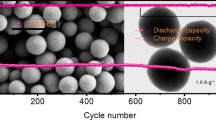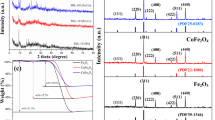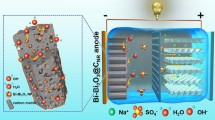Abstract
Bimetal oxides NiO/NiCo2O4 were successfully fabricated by using metal-organic frameworks (MOFs) as the precursor. The prepared NiO/NiCo2O4 showed hollow sphere and rod-like structures, respectively. When evaluated as an anode material for lithium-ion battery, a sphere-like NiO/NiCo2O4 showed an initial discharge capacity of 1778 mAh/g and reversible capacity of 920 mAh/g at 100 mA/g after 100 cycles. And a rod-like NiO/NiCo2O4 displayed initial discharge capacity of 1800 mAh/g and stabilized at an average capacity of 1198 mAh/g after 100 cycles. The results showed that the materials with the rod-like structure were much more stable and had better rate capability and more superior cyclic stability. The rod-like structure had a shorter transmission distance of Li+, which could maintain its stable rod-like structure in the long-term cycle. This strategy could shed light on designing stable electrode materials for conversion devices and energy storages.








Similar content being viewed by others
References
Armand M, Tarascon JM (2008) Building better batteries. Nature 451(7179):652–657. https://doi.org/10.1038/451652a
Marom R, Amalraj SF, Leifer N, Jacob D, Aurbach D (2011) A review of advanced and practical lithium battery materials. J Mater Chem 21(27):9938. https://doi.org/10.1039/c0jm04225k
Tarascon JM, Armand M (2001) Issues and challenges facing rechargeable lithium batteries. Nature 414(6861):359–367. https://doi.org/10.1038/35104644
Ma Y, Ma Y, Bresser D, Ji Y, Geiger D, Kaiser U, Streb C, Varzi A, Passerini S (2018) Cobalt disulfide nanoparticles embedded in porous carbonaceous micro-polyhedrons interlinked by carbon nanotubes for superior lithium and sodium storage. ACS Nano 12(7):7220–7231. https://doi.org/10.1021/acsnano.8b03188
Liu Q, Zhu J, Zhang L, Qiu Y (2018) Recent advances in energy materials by electrospinning. Renew Sust Energ Rev 81:1825–1858. https://doi.org/10.1016/j.rser.2017.05.281
Wu HB, Chen JS, Hng HH, Lou XW (2012) Nanostructured metal oxide-based materials as advanced anodes for lithium-ion batteries. Nanoscale 4(8):2526–2542. https://doi.org/10.1039/c2nr11966h
Zhao Y, Li X, Yan B, **ong D, Li D, Lawes S, Sun X (2016) Recent developments and understanding of novel mixed transition-metal oxides as anodes in lithium ion batteries. Adv Energy Mater 6(8):1502175. https://doi.org/10.1002/aenm.201502175
Miszta K, de Graaf J, Bertoni G, Dorfs D, Brescia R, Marras S, Ceseracciu L, Cingolani R, van Roij R, Dijkstra M, Manna L (2011) Hierarchical self-assembly of suspended branched colloidal nanocrystals into superlattice structures. Nat Mater 10(11):872–876. https://doi.org/10.1038/nmat3121
** B, Zhou X, Huang L, Licklederer M, Yang M, Schmuki P (2016) Aligned MoOx/MoS2 core–shell nanotubular structures with a high density of reactive sites based on self-ordered anodic molybdenum oxide nanotubes. Angew Chem Int Ed 55(40):12252–12256. https://doi.org/10.1002/anie.201605551
Zhou W, Tay YY, Jia X, Yau Wai DY, Jiang J, Hoon HH, Yu T (2012) Controlled growth of SnO2@Fe2O3 double-sided nanocombs as anodes for lithium-ion batteries. Nanoscale 4(15):4459–4463. https://doi.org/10.1039/C2NR31239E
Cao W, Hu A, Chen X, Liu X, Liu P, Tang Q, Zhao XS (2016) NiO hollow microspheres interconnected by carbon nanotubes as an anode for lithium ion batteries. Electrochim Acta 213:75–82. https://doi.org/10.1016/j.electacta.2016.07.094
Qi X, Zheng W, Li X, He G (2016) Multishelled NiO hollow microspheres for high-performance supercapacitors with ultrahigh energy density and robust cycle life. Sci Rep 6:33241. https://doi.org/10.1038/srep33241
Liu L, Zhang H, Yang J, Mu Y, Wang Y (2015) Self-assembled novel dandelion-like NiCo2O4 microspheres@nanomeshes with superior electrochemical performance for supercapacitors and lithium-ion batteries. J Mater Chem A 3(44):22393–22403. https://doi.org/10.1039/c5ta07110k
Gao G, Wu HB, Dong B, Ding S, Lou XW (2015) Growth of ultrathin ZnCo2O4 nanosheets on reduced graphene oxide with enhanced lithium storage properties. Adv Sci 2(1–2):1400014. https://doi.org/10.1002/advs.201400014
Xu X, Cao K, Wang Y, Jiao L (2016) 3D hierarchical porous ZnO/ZnCo2O4 nanosheets as high-rate anode material for lithium-ion batteries. J Mater Chem A 4(16):6042–6047. https://doi.org/10.1039/c6ta00723f
Zhang C, **ao J, Lv X, Qian L, Yuan S, Wang S, Lei P (2016) Hierarchically porous Co3O4/C nanowire arrays derived from a metal–organic framework for high performance supercapacitors and the oxygen evolution reaction. J Mater Chem A 4(42):16516–16523. https://doi.org/10.1039/c6ta06314d
Gholipour-Ranjbar H, Soleimani M, Naderi HR (2016) Application of Ni/Co-based metal–organic frameworks (MOFs) as an advanced electrode material for supercapacitors. New J Chem 40(11):9187–9193. https://doi.org/10.1039/c6nj01449f
Li H, Liang M, Sun W, Wang Y (2016) Bimetal-organic framework: one-step homogenous formation and its derived mesoporous ternary metal oxide nanorod for high-capacity, high-rate, and long-cycle-life lithium storage. Adv Funct Mater 26(7):1098–1103. https://doi.org/10.1002/adfm.201504312
He D, Liu G, Pang A, Jiang Y, Suo H, Zhao C (2017) A high-performance supercapacitor electrode based on tremella-like NiC2O4@NiO core/shell hierarchical nanostructures on nickel foam. Dalton Trans 46(6):1857–1863. https://doi.org/10.1039/c6dt04500f
Wu Y, Meng J, Li Q, Niu C, Wang X, Yang W, Li W, Mai L (2017) Interface-modulated fabrication of hierarchical yolk–shell Co3O4/C dodecahedrons as stable anodes for lithium and sodium storage. Nano Res 10(7):2364–2376. https://doi.org/10.1007/s12274-017-1433-6
Chaikittisilp W, Hu M, Wang H, Huang H-S, Fujita T, Wu KCW, Chen L-C, Yamauchi Y, Ariga K (2012) Nanoporous carbons through direct carbonization of a zeolitic imidazolate framework for supercapacitor electrodes. Chem Commun 48(58):7259–7261. https://doi.org/10.1039/C2CC33433J
Chaikittisilp W, Ariga K, Yamauchi Y (2013) A new family of carbon materials: synthesis of MOF-derived nanoporous carbons and their promising applications. J Mater Chem A 1(1):14–19. https://doi.org/10.1039/C2TA00278G
Furukawa H, Cordova KE, O’Keeffe M, Yaghi OM (2013) The chemistry and applications of metal-organic frameworks. Science 341(6149):1230444. https://doi.org/10.1126/science.1230444
Tang J, Liu J, Li C, Li Y, Tade MO, Dai S, Yamauchi Y (2015) Synthesis of nitrogen-doped mesoporous carbon spheres with extra-large pores through assembly of diblock copolymer micelles. Angew Chem 127(2):598–603. https://doi.org/10.1002/ange.201407629
Kaneti YV, Zhang J, He Y-B, Wang Z, Tanaka S, Hossain MSA, Pan Z-Z, **ang B, Yang Q-H, Yamauchi Y (2017) Fabrication of an MOF-derived heteroatom-doped Co/CoO/carbon hybrid with superior sodium storage performance for sodium-ion batteries. J Mater Chem A 5(29):15356–15366. https://doi.org/10.1039/C7TA03939E
Castarlenas S, Téllez C, Coronas J (2017) Gas separation with mixed matrix membranes obtained from MOF UiO-66-graphite oxide hybrids. J Membr Sci 526:205–211. https://doi.org/10.1016/j.memsci.2016.12.041
Kang Z, Fan L, Sun D (2017) Recent advances and challenges of metal–organic framework membranes for gas separation. J Mater Chem A 5(21):10073–10091. https://doi.org/10.1039/c7ta01142c
Bhadra BN, Song JY, Khan NA, Jhung SH (2017) TiO2-containing carbon derived from a metal-organic framework composite: a highly active catalyst for oxidative desulfurization. ACS Appl Mater Interfaces 9(36):31192–31202. https://doi.org/10.1021/acsami.7b10336
Bag PP, Wang D, Chen Z, Cao R (2016) Outstanding drug loading capacity by water stable microporous MOF: a potential drug carrier. Chem Commun 52(18):3669–3672. https://doi.org/10.1039/c5cc09925k
Niu JL, Zeng CH, Peng HJ, Lin XM, Sathishkumar P, Cai YP (2017) Formation of N-doped carbon-coated ZnO/ZnCo2O4/CuCo2O4 derived from a polymetallic metal-organic framework: toward high-rate and long-cycle-life lithium storage. Small 13(47). https://doi.org/10.1002/smll.201702150
He Z, Wang K, Zhu S, Huang LA, Chen M, Guo J, Pei S, Shao H, Wang J (2018) MOF-Derived hierarchical MnO-doped Fe3O4@C composite nanospheres with enhanced lithium storage. ACS Appl Mater Interfaces 10(13):10974–10985. https://doi.org/10.1021/acsami.8b01358
He S, Li Z, Wang J, Wen P, Gao J, Ma L, Yang Z, Yang S (2016) MOF-derived NixCo1−x(OH)2 composite microspheres for high-performance supercapacitors. RSC Adv 6(55):49478–49486. https://doi.org/10.1039/c6ra03992h
Hu Z, Peng Y, Kang Z, Qian Y, Zhao D (2015) A modulated hydrothermal (MHT) approach for the facile synthesis of UiO-66-type MOFs. Inorg Chem 54(10):4862–4868. https://doi.org/10.1021/acs.inorgchem.5b00435
Wen P, Gong P, Sun J, Wang J, Yang S (2015) Design and synthesis of Ni-MOF/CNT composites and rGO/carbon nitride composites for an asymmetric supercapacitor with high energy and power density. J Mater Chem A 3(26):13874–13883. https://doi.org/10.1039/c5ta02461g
Yang J, Zheng C, **ong P, Li Y, Wei M (2014) Zn-doped Ni-MOF material with a high supercapacitive performance. J Mater Chem A 2(44):19005–19010. https://doi.org/10.1039/c4ta04346d
Yang J, **ong P, Zheng C, Qiu H, Wei M (2014) Metal–organic frameworks: a new promising class of materials for a high performance supercapacitor electrode. J Mater Chem A 2(39):16640–16644. https://doi.org/10.1039/c4ta04140b
Zhu D, Zheng F, Xu S, Zhang Y, Chen Q (2015) MOF-derived self-assembled ZnO/Co3O4 nanocomposite clusters as high-performance anodes for lithium-ion batteries. Dalton Trans 44(38):16946–16952. https://doi.org/10.1039/c5dt02271a
Peng H-J, Hao G-X, Chu Z-H, Lin Y-W, Lin X-M, Cai Y-P (2017) Porous carbon with large surface area derived from a metal–organic framework as a lithium-ion battery anode material. RSC Adv 7(54):34104–34109. https://doi.org/10.1039/c7ra05090a
Huang G, Zhang L, Zhang F, Wang L (2014) Metal–organic framework derived Fe2O3@NiCo2O4 porous nanocages as anode materials for Li-ion batteries. Nanoscale 6(10):5509–5515. https://doi.org/10.1039/C3NR06041A
Hu L, Yan N, Chen Q, Zhang P, Zhong H, Zheng X, Li Y, Hu X (2012) Fabrication based on the Kirkendall effect of Co3O4 porous nanocages with extraordinarily high capacity for lithium storage. Chem-Eur J 18(29):8971–8977. https://doi.org/10.1002/chem.201200770
Marco JF, Gancedo JR, Gracia M, Gautier JL, Ríos EI, Palmer HM, Greaves C, Berry FJ (2001) Cation distribution and magnetic structure of the ferrimagnetic spinel NiCo2O4. J Mater Chem 11(12):3087–3093. https://doi.org/10.1039/B103135J
Han Y, Li J, Zhang T, Qi P, Li S, Gao X, Zhou J, Feng X, Wang B (2018) Zinc/nickel-doped hollow core–shell Co3O4 derived from a metal–organic framework with high capacity, stability, and rate performance in lithium/sodium-ion batteries. Chem-Eur J 24(7):1651–1656. https://doi.org/10.1002/chem.201704416
Li J, **ong S, Liu Y, Ju Z, Qian Y (2013) High Electrochemical Performance of monodisperse NiCo2O4 mesoporous microspheres as an anode material for Li-ion batteries. ACS Appl Mater Interfaces 5(3):981–988. https://doi.org/10.1021/am3026294
Marco JF, Gancedo JR, Gracia M, Gautier JL, Ríos E, Berry FJ (2000) Characterization of the nickel cobaltite, NiCo2O4, prepared by several methods: an XRD, XANES, EXAFS, and XPS study. J Solid State Chem 153(1):74–81. https://doi.org/10.1006/jssc.2000.8749
Zhong J-H, Wang A-L, Li G-R, Wang J-W, Ou Y-N, Tong Y-X (2012) Co3O4/Ni(OH)2 composite mesoporous nanosheet networks as a promising electrode for supercapacitor applications. J Mater Chem 22(12):5656–5665. https://doi.org/10.1039/C2JM15863A
Xu J, Tang H, Xu T, Wu D, Shi Z, Tian Y, Li X (2017) Porous NiO hollow quasi-nanospheres derived from a new metal-organic framework template as high-performance anode materials for lithium ion batteries. Ionics 23(12):3273–3280. https://doi.org/10.1007/s11581-017-2160-4
Sun C, Yang J, Rui X, Zhang W, Yan Q, Chen P, Huo F, Huang W, Dong X (2015) MOF-directed templating synthesis of a porous multicomponent dodecahedron with hollow interiors for enhanced lithium-ion battery anodes. J Mater Chem A 3(16):8483–8488. https://doi.org/10.1039/c5ta00455a
Hu X, Li C, Lou X, Yang Q, Hu B (2017) Hierarchical CuO octahedra inherited from copper metal–organic frameworks: high-rate and high-capacity lithium-ion storage materials stimulated by pseudocapacitance. J Mater Chem A 5(25):12828–12837. https://doi.org/10.1039/c7ta02953e
Fan Z, Wang B, ** Y, Xu X, Li M, Li J, Coxon P, Cheng S, Gao G, **ao C, Yang G, ** K, Ding S, Kumar RV (2016) A NiCo2O4 nanosheet-mesoporous carbon composite electrode for enhanced reversible lithium storage. Carbon 99:633–641. https://doi.org/10.1016/j.carbon.2015.12.035
Ren Q-Q, Wang Z-B, Ke K, Zhang S-W, Yin B-S (2017) NiCo2O4 nanosheets and nanocones as additive-free anodes for high-performance Li-ion batteries. Ceram Int 43(16):13710–13716. https://doi.org/10.1016/j.ceramint.2017.07.083
Li T, Li X, Wang Z, Guo H, Li Y (2015) A novel NiCo2O4 anode morphology for lithium-ion batteries. J Mater Chem A 3(22):11970–11975. https://doi.org/10.1039/c5ta01928a
Yang F, Li W, Tang B (2018) Two-step method to synthesize spinel Co3O4-MnCo2O4 with excellent performance for lithium ion batteries. Chem Eng J 334:2021–2029. https://doi.org/10.1016/j.cej.2017.11.157
Sun Y, Huang F, Li S, Shen Y, **e A (2017) Novel porous starfish-like Co3O4@nitrogen-doped carbon as an advanced anode for lithium-ion batteries. Nano Res 10(10):3457–3467. https://doi.org/10.1007/s12274-017-1557-8
Han Y, Zhao M, Dong L, Feng J, Wang Y, Li D, Li X (2015) MOF-derived porous hollow Co3O4 parallelepipeds for building high-performance Li-ion batteries. J Mater Chem A 3(45):22542–22546. https://doi.org/10.1039/c5ta06205e
Chen Y, Wu J, Yang W, Fu Y, Zhou R, Chen S, Zhang L, Song Y, Wang L (2016) Zn/Fe-MOFs-derived hierarchical ball-in-ball ZnO/ZnFe2O4@carbon nanospheres with exceptional lithium storage performance. J Alloys Compd 688:211–218. https://doi.org/10.1016/j.jallcom.2016.07.011
Li Y, Wu X (2017) Fabrication of urchin-like NiCo2O4 microspheres assembled by using SDS as soft template for anode materials of Lithium-ion batteries. Ionics 24(5):1329–1337. https://doi.org/10.1007/s11581-017-2291-7
Mondal AK, Su D, Chen S, Kretschmer K, **e X, Ahn HJ, Wang G (2015) A microwave synthesis of mesoporous NiCo2O4 nanosheets as electrode materials for lithium-ion batteries and supercapacitors. Chemphyschem 16(1):169–175. https://doi.org/10.1002/cphc.201402654
Funding
This work was supported by the National Natural Science Foundation of China (21475021 and 21427807) and the Fundamental Research Funds for the Central Universities (2242017K41023).
Author information
Authors and Affiliations
Corresponding author
Ethics declarations
Conflict of interest
The authors declare that they have no conflict of interest.
Additional information
Publisher’s note
Springer Nature remains neutral with regard to jurisdictional claims in published maps and institutional affiliations.
Electronic supplementary material
ESM 1
(DOC 4205 kb)
Rights and permissions
About this article
Cite this article
Chen, J., Jiang, J., Liu, S. et al. MOF-derived bimetal oxides NiO/NiCo2O4 with different morphologies as anodes for high-performance lithium-ion battery. Ionics 25, 5787–5797 (2019). https://doi.org/10.1007/s11581-019-03152-9
Received:
Revised:
Accepted:
Published:
Issue Date:
DOI: https://doi.org/10.1007/s11581-019-03152-9




